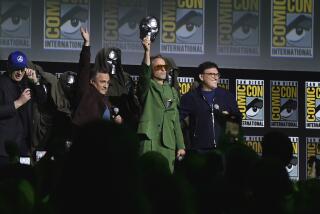‘X-Men: Days of Future Past’ ups the ante on super-sequels
- Share via
As Hollywood studios continue to mine existing properties and milk their blockbuster franchises, moviegoers have grown accustomed to a seemingly endless parade of sequels, prequels and reboots. Now the superhero epic “X-Men: Days of Future Past,” opening Friday, is taking character crossovers and franchise maneuvering to the next level.
While other superhero, sci-fi and fantasy films have jumped through hoops to extend their lifespans and expand their scope, few have gone to as much trouble as “Days of Future Past.” The pretzel-logic plotting is complicated, so pay attention.
Directed by Bryan Singer, who kicked off the “X-Men” franchise 14 years ago, “Days of Future Past” has the unusual distinction of being a direct sequel to two movies at once. Thanks to a time-traveling storyline, it picks up where both the contemporary-set “X-Men: The Last Stand” (2006) and the 1962-set “X-Men: First Class” (2011) left off.
In doing so, “Days of Future Past” takes a more-is-more approach and unites two separate casts, with some characters being played by multiple actors: James McAvoy and Michael Fassbender play young versions of the telepathic Professor X and the metal-bending Magneto, respectively, while Patrick Stewart and Ian McKellen play their older counterparts.
Perhaps the closest examples of a single movie serving as the sequel to two others come from elsewhere in the Marvel universe: “Iron Man 3” and “Captain America: The Winter Soldier.” While continuing their titular franchises, those films also dealt with the fallout from the all-star team-up “The Avengers.” Iron Man (Robert Downey Jr.) grappled with post-traumatic stress after an alien invasion, and Cap (Chris Evans) continued to work for SHIELD while trying to adapt to the modern world.
That said, neither film merges two separate timelines and casts the way “Days of Future Past” does. There’s no older (or younger) version of Iron Man played by a different actor, for example. It’s a rather more ambitious task, and a more fraught one.
Another idiosyncrasy of “Days of Future Past” is that it’s also a sequel to a prequel and is largely set between “First Class” and the “The Last Stand” (not to mention the original “X-Men” and “X-2”). One of the challenges faced by the movie is filling in the gaps of a known story while remaining both compelling and coherent.
In that sense, “Days of Future Past” is reminiscent of both George Lucas’ “Star Wars” prequel trilogy and Peter Jackson’s “The Hobbit” trilogy.
It bodes well for “Days of Future Past” that critics’ and audiences’ reactions improved over the course of those two series: “Attack of the Clones” fared better than “The Phantom Menace,” and “Revenge of the Sith” fared best of all, while “The Desolation of Smaug” improved upon “An Unexpected Journey.” Indeed, successful sequels often build on the narrative framework established by their predecessors.
On yet another level, “Days of Future” appears poised to serve as a series handoff, shifting the focus from the adventures of the original cast to the upstarts of “First Class.” A “Days of Future Past” sequel, “X-Men: Apocalypse,” has already been announced and is said to focus on the younger cast.
One popular franchise that has pulled off the same feat — twice — is “Star Trek.” 1991’s “Star Trek VI: The Undiscovered Country” and 1994’s “Star Trek Generations” transitioned from Capt. Kirk (William Shatner) and his crew to their successors led by Capt. Picard (played by none other than future “X-Men” star Stewart). The “Generations” crew would go on to star in three more movies.
More recently, J.J. Abrams rebooted the franchise with 2009’s “Star Trek,” starring Chris Pine as a younger version of Kirk in an alternate timeline, which freed future installments from the baggage of their predecessors. The film was a hit, spawning the follow-up “Star Trek Into Darkness” last year and a planned third installment.
If the “X-Men” franchise is able to similarly streamline and keep up its momentum, its future — based on its past — will likely look bright.
More to Read
Only good movies
Get the Indie Focus newsletter, Mark Olsen's weekly guide to the world of cinema.
You may occasionally receive promotional content from the Los Angeles Times.










